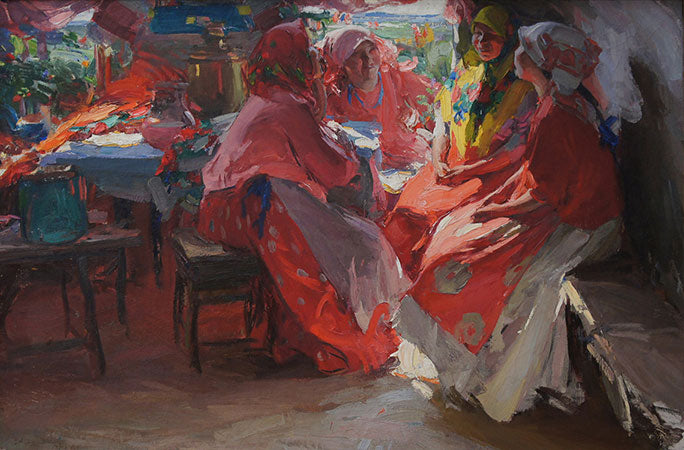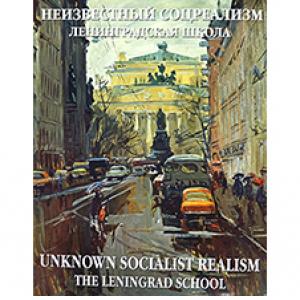Filipp Malyavin: From Russian Impressionism to Abstraction
by Cathy Locke

"A Peasant Young Girl," 1903, oil on canvas
Filipp Malyavin (1869–1940) was born into a very poor peasant family in the rural village of Kazanka in the mid-section of Russia. At the age of sixteen, he convinced his parents to allow him to go to Mount Athos, Greece to study icon painting, with his entire journey financed by the villagers where his family lived. When Malyavin reached the Monastery of Agiou Panteleimonos on Mount Athos, he was disappointed to learn that they made only copies of Russian icons. Having used up his money and unable to return to Russia, Malyavin entered the monastery as a novice where he gained experience painting icons and murals. In 1891 he met Vladimir Beklemishev, a professor at the Imperial Academy in St. Petersburg, who was visiting Mount Athos. Beklemishev was so impressed with Malyavin’s work that he paid for Malyavin's enrollment at the Imperial Academy.

"Portrait of Konstantin Somov" 1895
Imperial Academy
In 1892 Malyavin began his studies at the Imperial Academy where he studied under Pavel Chistyakov (1832-1919), Vasily Vereschagin (1842-1904) and Ilya Repin (1844-1930). His fellow students included Igor Grabar, Konstantin Somov, Anna Ostroumova-Lebedeva and Boris Kustodiev. His early work was most influenced by Repin through his skill in portraiture. Two of his most famous portraits that were painted while at school are of fellow students Somov and Ostroumova-Lebedeva, both of which are at the Russian Museum in St. Petersburg.

“Portrait of the Artist Anna Ostroumova,” 1896, oil on canvas

Details of “Portrait of the Artist Anna Ostroumova,” 1896, oil on canvas
Although Malyavin was trained by the realist painter Ilya Repin, he was strongly influenced by the French Impressionists and the Scandinavian artist Anders Zorn (1860-1920). As Malyavin developed as an artist his brushwork began to become much more loose than his eariler portrait work. Malyavin preferred to work on large canvases where he could get very expressive. His graduation painting, Laughter (1899), was actually rejected by the majority of voters at the Academy. Despite this fact, Malyavin was still awarded a degree and that same painting won the gold medal at the World Exhibition in Paris (1900). That same year, Malyavin married fellow student Natalia Novak-Savich and went on to became a member of the Wanderers and the World of Art.

"Laughter," 1899, oil on canvas
Peasant Paintings
Keeping with his humble upbringing Malyavin became famous for his brightly-colored paintings of peasants. The most well-known painting of that series, Whirlwind (1906), which secured him a position as a professor at the Imperial Academy.

(Left) “Verka,” 1913, oil on canvas; (Right) “Two Peasant Girls,” date unknown, oil on canvas
About this Painting: Whirlwind
Here Malyavin melds Russian Impressionism with abstraction. Drawing on his own personal history he creates " heroines of old-Russian legends." The clothing of these peasant women become streams of warm and cool color that dance around the canvas. The influence of the artist Anders Zorn is seen in Malyavin's bold brushwork. We can also see influences of sound painting that Russian artists Wassily Kandinsky and Nikolai Milioti were also experimenting with during this time period. Malyavin uses this technique to create dynamic sweeping movements that produce rhythm. On the recommendation of Igor Grabar, Malyavin used slow drying oils to better control this large canvas.
Historically it is important to note that Malyavin painted "Whirlwind" right after Bloody Sunday (October 17, 1905); the date that marks the first Russian revolution. This was a traumatic event where peaceful demonstrators, many of which were women and children, were killed near the Imperial Academy. We can read into this painting an unleashing of both spiritual revival and destructive forces.

"Whirlwind," 1906, oil on canvas
Malyavin moved to Moscow in 1920, where he did portrait drawings of Lenin, Trotsky and Lunacharsky. The political current during this time had a great influence over Malyavin and we see a dramatic shift in his style. Stalin was becoming a powerful man and was changing the focus of art allowed in Russia. He declared that the only paintings that could be shown had to have “educational value.” At this time there was a large collection of French impressionist, post-impressionist and favist paintings in Russia. All of these paintings were taken off of their stretcher bars, rolled, then packed into trains and shipped off to Sibera, all because they contained no educational value. Kazimir Malevich’s work was described by Stalin as “bourgeois” art. His work was confiscated and he was banned from creating and exhibiting. Themes of happy Russian life painted in a realistic style replaced all other previous styles of art.

"Peasant Girl with Embroidery," 1920(?) oil on canvas
Leaving Russia
In 1922, while traveling to Berlin and Paris to attend his solo exhibitions, he decided to emigrate. He lived in Paris and Nice throughout the 1930s during which time he painted many portraits, including King Gustav V, Prince Eugen and Princess Ingrid of Sweden (1936). In 1940 he was arrested by the Gestapo in Brussels and was accused of espionage. He was released a few months later and, at the age of seventy-one, he was forced to return to Nice on foot. Malyavin died in Nice later that year.
About the Author
Cathy Locke is an award-winning fine art painter, professor, and published writer, specializing in Russian art of the 19th and 20th centuries. She is the editor of Musings-on-Art.org.
Cathy’s artwork: www.cathylocke.com








